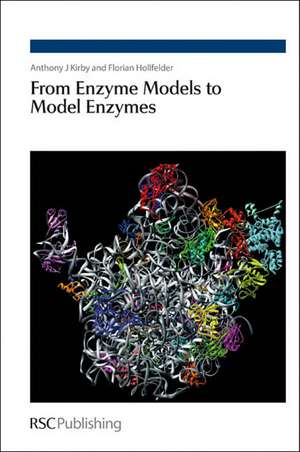From Enzyme Models to Model Enzymes
Autor Anthony J. Kirby, Florian Hollfelderen Limba Engleză Hardback – 30 sep 2009
Designing artificial systems with catalytic efficiencies to rival those of natural enzymes is one of the great challenges facing science today. Our current level of understanding fails the basic, practical test - designing and making artificial systems with catalytic efficiencies to rival those of natural enzymes. Chemists and bio-scientists are well aware of this problem, and "artificial enzymes" have been a "hot topic" for many years. However, until now, there has been no book devoted specifically to this subject. This is the first book to provide a critical introduction to, and overview of, this exciting area. It is aimed at students and more senior researchers with specialist or general interests in the field. The book starts with a systematic overview of the most important properties of natural enzymes, with special emphasis on mechanisms and efficiency of catalysis. This is followed by a summary of the mechanisms involved in the major classes of reaction they catalyze, and spells out the logical progression from simple mechanistic models for particular reactions to the first, rudimentary artificial enzymes catalyzing them. Catalytic efficiency is the key criterion for inclusion. An analysis of the strengths and limitations of the classical design-based approach to catalysis by enzyme mimics leads on to a discussion of recent advances which use selection methods coupled with iterative techniques for creating and improving catalysts by natural methods. The comparison of natural and artificial catalysts requires a quantitative understanding based on the interpretation of kinetic measurements. Key skills in data interpretation are introduced in a guided approach that connects the formal treatment of kinetic measurements with their chemical and biological interpretation.
Preț: 1027.50 lei
Preț vechi: 1194.76 lei
-14% Nou
Puncte Express: 1541
Preț estimativ în valută:
196.60€ • 205.29$ • 162.35£
196.60€ • 205.29$ • 162.35£
Carte tipărită la comandă
Livrare economică 15-29 aprilie
Preluare comenzi: 021 569.72.76
Specificații
ISBN-13: 9780854041756
ISBN-10: 0854041753
Pagini: 273
Dimensiuni: 157 x 240 x 20 mm
Greutate: 0.54 kg
Ediția:Edition.
Editura: Royal Society Of Chemistry
ISBN-10: 0854041753
Pagini: 273
Dimensiuni: 157 x 240 x 20 mm
Greutate: 0.54 kg
Ediția:Edition.
Editura: Royal Society Of Chemistry
Cuprins
Introduction Evaluation Classification by model system Classification by reaction Problems Glossary Index
Recenzii
"The organizational is logical, progressing from an introduction of the principles of catalysis through model systems to more sophisticated efforts that include biochemical methods to improve the catalytic function of proteins." "The coverage of topics is broad rather than deep, consistent with the authors' goal of introducing enzyme models to a wide readership." "Overall this is a valuable mongraph, particularly for those who are reasonably conversant with the underlying principles of catalysis. The text is very well written and the coverage of the topic is sufficient to give a broad overview of the field."
Notă biografică
Anthony J. Kirby is Professor (Emeritus) of Bioorganic Chemistry at the University of Cambridge. He has over 40 years teaching and research experience in the area and has authored over 300 papers and 3 books. Florian Hollfelder has been lecturing in Biochemistry since 2001. He has a total of 15 years teaching and research experience at Cambridge, Stanford & Harvard and has authored more than 30 papers.
Textul de pe ultima copertă
Enzymes are the (impeccably green) catalysts that make the Chemistry of Life run smoothly and efficiently, and understanding how they work has been a major challenge for Biological Science for many years. Despite tremendous progress our understanding still fails the ultimate, practical test - of designing and making artificial systems with catalytic efficiencies to rival those of natural enzymes. "Artificial enzymes" has been a hot topic for many years, but until now no textbook has been devoted specifically to this subject. From Enzyme Models to Model Enzymes is the first to provide a critical introduction to, and overview of, this exciting area. It is aimed at both students and more senior researchers with interests in the field. The book starts with a systematic overview of the most important properties of natural enzymes, with special emphasis on mechanisms and catalytic efficiency. There follows a summary of the mechanisms involved in the major classes of reaction they catalyze, and of the logical progression from simple mechanistic models for particular reactions to the first, rudimentary model enzymes. Catalytic efficiency is the key criterion for inclusion. A careful analysis of the strengths and limitations of the classical design-based approach to catalysis by enzyme mimics leads on to a critical discussion of recent advances, which combine selection routines with iterative techniques for creating and improving catalysts by biomimetic methods. The meaningful comparison of natural and artificial catalysts requires a quantitative understanding based on the interpretation of kinetic measurements. Key skills in data interpretation are introduced in a guided approach that connects the formal treatment of kinetic measurements with their chemical and biological mechanistic interpretation. This book provides a convenient entry point into the chemistry for the biochemist and molecular biologist, and for the chemist an entrée into the biological methods that are of rapidly growing importance in this and a number of other topical areas.
Descriere
This introduction to the exciting area of artificial enzymes is suitable for students and more senior researchers.










